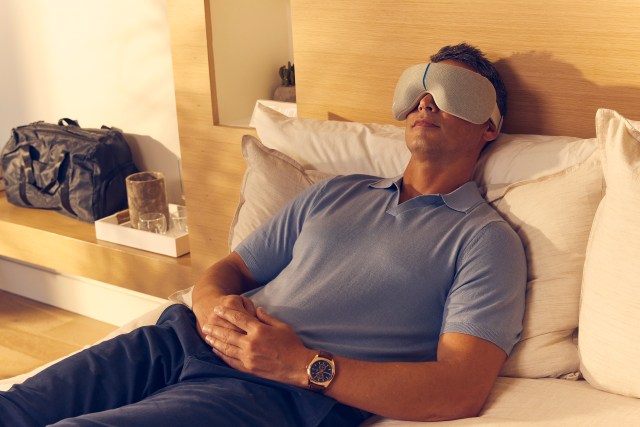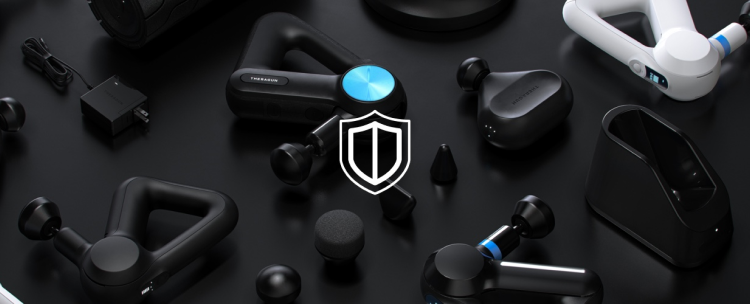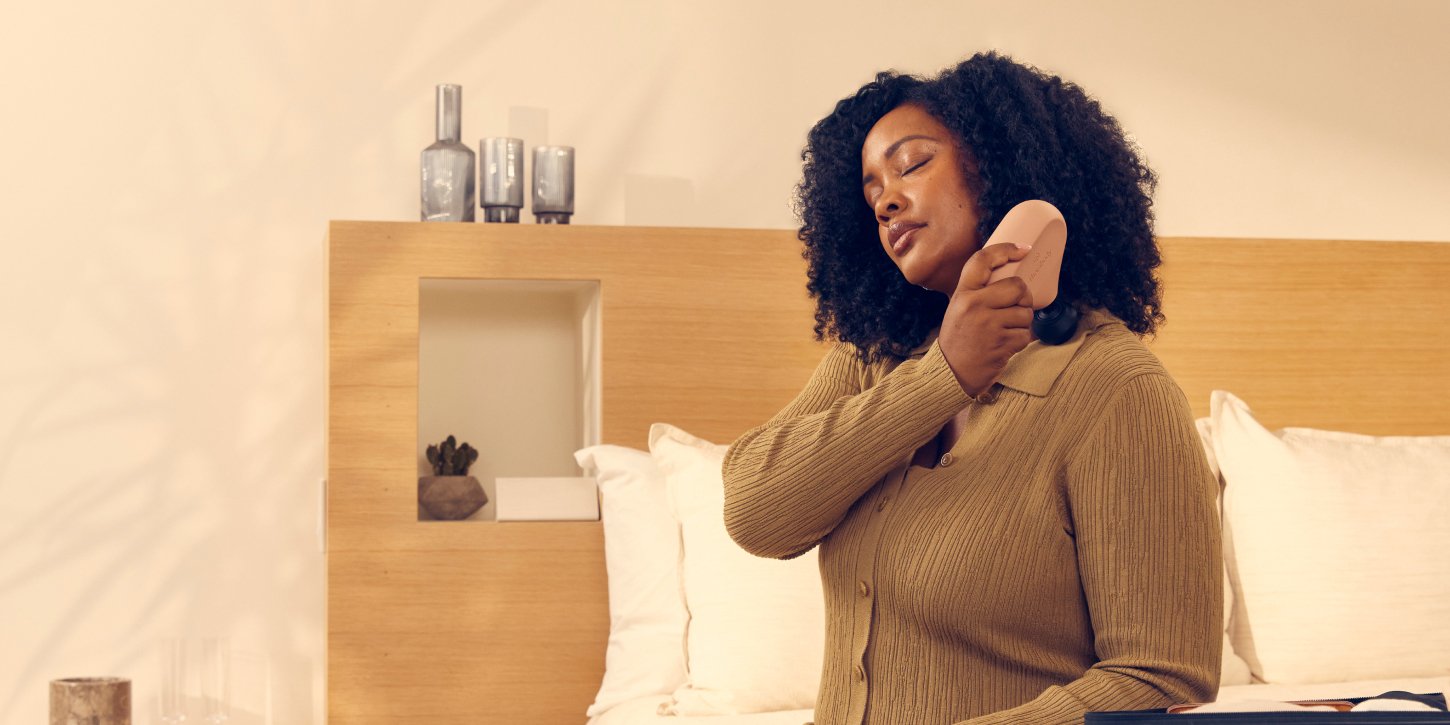Authors: Therabody Scientists: Tim Roberts, MSc; Kyle Silvey, PhD; Michelle Darian, MS, MPH, RD, LDN
Sleeping well is a must for good health. Decades of research show how getting enough quality sleep is critical to wellness. It improves cognition (like memory and concentration), hormone regulation (especially those related to appetite), immune function, performance, recovery, stress, and mood. [1–7]
But despite the vast data showing how quality shut-eye is essential, 35% of U.S. adults do not meet the recommended seven to nine hours of sleep a night. [8] So, there’s a lot of room for improvement. While it’s up to you to carve out 7-9 hours to be in bed, there’s a lot you can do to set yourself up to actually sleep that long.
How To Improve Your Sleep
Over 9 million Americans rely on prescription sleep aids to help them snooze. [9] Although these medications can be warranted (and helpful) for certain medical conditions, they shouldn’t alwaysbe the first-choice solution for everyone. Instead, taking note of lifestyle factors that cancontribute to poor sleep and prioritizing improving them can help to improve sleep.
Trying to fall asleep while running in circles (physically or mentally) is not the best idea. Thesetips focus on clearing mental stress and relaxing sore and tense muscles. At Therabody, wefocus on the four mainpillars of an optimal sleep environment: relaxed, cooled, quiet, and dark.Here are eight science-backed things you can do to fall asleep faster and stay asleep longer(using both simple techniques and the latest tech gadgets).
1. Take a few deep breaths
Breathing exercises can help you relax and prepare the body for sleep. It does so by switching the body’s nervous system from a state of stress to calm. [10]
A research-backed breathing technique to practice before bed is the 4-7-8 breathing exercise. [11] It follows an inhale, hold, exhale pattern for four, seven, and eight seconds, respectively.
Instructions:
- Inhale for four seconds through the nose
- Pause for seven seconds (at the top of your inhale)
- Exhale slowly (but forcefully) through the mouth for eight seconds with the lips parted, making a whooshing sound
- Repeat
You can do this lying down in bed with your eyes closed to help you fall asleep. Consider starting with five to six cycles. If you want to keep going, take a minute or so break before starting another set. [12]
2. Apply gentle vibrations to your eyes and temples
Muscles in the eyes and temples are sensitive to stress and tension building, and a gentlemassage can help.Research reveals that gentle, rhythmic movement can promote sleepiness.Similar to techniques used tosoothe babies to sleep—like rocking chairs or car rides—vibration-like movements also help adults relax and nod off. Vibrations ease tension in the body,enabling people to not only fall asleep faster but also experience deeper and more restorativesleep overall. [13, 14, 15]
While you can use your fingers or knuckles along your temples, Therabody’s SmartGoggles harness the power of vibration technology and science-backed routines to eliminate the guesswork and physical work for you. Resembling a sleeping mask, SmartGoggles delivers gentle cyclical vibrations and heat therapy — scientifically proven methods to improve sleep quality.
While this isn’t a mask you sleep in, you can put it on right before bed while lying down and feel the physical and mental stress melt away.

3. Work out stiff and sore muscles
If your body is not physically relaxed, it can hinder your ability to fall asleep. Whether your muscles are tight from stress or the lingering effects of a tough workout, you may benefit from percussive therapy. Percussive therapy delivers rapid, concentrated pulses or vibrations and is the type of treatment that massage guns — like the Theragun — provide.
A study measured the use of the Theragun before bed and showed that it can help improve sleep. Participants only used the Theragun sleep routines for two weeks of the study, but the impact was clear:
- Sleep latency, the time it takes to fall asleep, decreased by 87% compared to baseline.
- Sleep efficiency, the time spent asleep compared to the total time spent in bed, increased by 70%.
- People reported a 9% and 5% reduction in pain and soreness, respectively.
4. Relax restless muscles
Another way to help calm restless muscles is to use pneumatic compression. Pneumatic compression is a type of compressive therapy generated by a pump to control the amount of pressure and the intervals at which pressure is delivered to the treatment area (that is cuffed in a sleeve or a boot).
This therapy has decades of data showing its effectiveness for everything from muscle soreness to swelling, but emerging research shows that pneumatic compression before bed may be beneficial for those with restless legs syndrome. [16]
Restless legs syndrome is a neurological disorder that causes an uncomfortable feeling in the legs and an irresistible urge to move them. This intensity increases at night and can severely interfere with sleep quality. It’s estimated that around 7-10% of adults in the U.S. have this condition, which there is currently no cure for. [17]
The sleep benefits of pneumatic compression circle back to the device’s ability to improve blood flow. [18] It’s important to speak with a healthcare provider to determine if pneumatic compression is right for you.
5. Lower the temperature of the room with an air conditioner or fan
It’s hard, if not impossible, to sleep if your room is hot and stale. Research shows time and time again that the best temperature for sleeping is around 65 degrees Fahrenheit (or 18.3 degrees Celsius). This may vary a few degrees from person to person, but the maximum recommended sleeping temperature hovers around 70 degrees Fahrenheit. [19]
If you have air conditioning, use it to cool your room down. If it’s a cool evening and it’s safe to do so, opening a window can also help.
Cooling down your body can also work if you don’t have access to an air-cooling option. Cooling devices applied to the skin have also been shown to help improve sleep in hot environments. [20, 21]
6. Listen to relaxing music or white noise
Some people have no problem falling asleep in loud airports or during a blaring movie. But even if you can do that, it doesn’t mean you should. Aim for a quiet room or one with relaxing sounds.
Scientists have explored the physical, biological, and mental effects of various musical elements and audio techniques. Sound therapy can provide benefits like relaxation and stress reduction.It can help you find your “off" button by engaging parts of your brain while letting the ones connected to stress or mental agitation relax. [22] In turn, you fall asleep, stay asleep, and sleep soundly.
When you connect your Theragun Sense to the Therabody App, you uncover relaxing sounds that you can use before bed. Use the massage gun before bed to relax your muscles and tune into your favorite soothing audio track to help lull you to sleep.
7. Avoid screens like TVs, phones, and laptops before bed
Again, some people can fall asleep in rooms withblinding lights or bright screens nearby.However, that can be detrimental to your sleep health in the long run. As difficult as it may be,try to stop screen use at least two hours before bed. Exposure to any light (including blue light)delays melatoninproduction—the hormone that promotes sleepiness. [23]
Try to stop screen use at least two hours before bed. If that’s not possible, you may want to try wearing blue light glasses, getting an app that filters the light output on your screens, or setting your devices to dim after sunset.
If you can’t avoid blue light altogether before bed, try wearing a pair of blue light glasses, getting an app that filters the light output on your screens, or setting your devices to dim after the sun goes down.
8. Wear an eye mask to bed
If you don’t feel like replacing the blinds or shades in your room, wearing an eye mask to bed is an effective solution.
Eye masks block out light that can also disrupt melatonin production and misalign your greater circadian rhythm — the 24-hour clock that governs physical, mental, and behavioral changes. [24] Keeping your bedroom dark, especially if your sleeping window has you rising after the sun, can help keep you asleep.
Key Takeaways
- Sleeping well is crucial for optimal health — but upwards of 35% of adults in the U.S. do not meet the nightly recommendations for seven to nine hours of sleep.
- Prescription sleep aids aren’t a long-term solution. Instead, start by altering your sleep habits and integrating technology into your routine to help catch some quality ZZZs.
- Therabody products provide research-backed therapies (including vibration, percussive, and sound) that can help relax the mind and body — priming you for the best night’s sleep possible.
References
- https://pubmed.ncbi.nlm.nih.gov/21532950/
- https://pubmed.ncbi.nlm.nih.gov/21532950/
- https://pubmed.ncbi.nlm.nih.gov/36404495/
- https://pubmed.ncbi.nlm.nih.gov/21835655/
- https://pubmed.ncbi.nlm.nih.gov/35881527/
- https://pubmed.ncbi.nlm.nih.gov/27067616/
- https://pubmed.ncbi.nlm.nih.gov/28673415/
- https://www.cdc.gov/mmwr/preview/mmwrhtml/mm6008a2.htm?s_cid=mm6008a2_w
- https://pubmed.ncbi.nlm.nih.gov/24152538/
- https://pubmed.ncbi.nlm.nih.gov/30245619/
- https://pubmed.ncbi.nlm.nih.gov/36480101/
- https://www.ncbi.nlm.nih.gov/pmc/articles/PMC9277512/
- https://pubmed.ncbi.nlm.nih.gov/31554268/
- https://pubmed.ncbi.nlm.nih.gov/33367712/
- https://ieeexplore.ieee.org/document/9086332
- https://pubmed.ncbi.nlm.nih.gov/19017878/
- https://www.ninds.nih.gov/health-information/disorders/restless-legs-syndrome
- https://www.jvascsurg.org/article/S0741-5214(02)75244-0/fulltext
- https://www.ncbi.nlm.nih.gov/pmc/articles/PMC6491889/
- https://pubmed.ncbi.nlm.nih.gov/28960513/
- https://pubmed.ncbi.nlm.nih.gov/12750972/
- https://www.ncbi.nlm.nih.gov/pmc/articles/PMC9163611/
- https://pubmed.ncbi.nlm.nih.gov/35286195/
- https://pubmed.ncbi.nlm.nih.gov/34514653/







